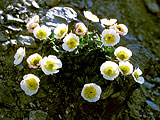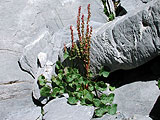 |
|
|
|
|
|
|
Why does a reduction of the season length lead to high nutrient concentrations? This phenomenon is called "luxurious consumption". Alpine plants of various climates produce few, short-lived and highly productive leaves in order to make maximum use of the short season. Often, the dry matter content is reduced and leaves become thicker (more cell layers). |
|
1 - Ranunculus glacialis (Ranunculaceae), one of the highest climbing vascular plant species of the Alps and the Scandes - soft, protein rich leaves (2600 m, Austrian Alps). |
Some alpine plant species, such as Ranunculus glacialis and Oxyria digyna may have concentrations of up to 5 % nitrogen in leaves, which means one third of their leaf dry matter is protein (5 times 6.25, the mean conversion factor of N to protein mass). Common concentrations in non-evergreen leaves are 2-3 % N. |
2 - Oxyria digyna (Polygonaceae), a widespread arctic-alpine species found across the northern hemisphere - soft, protein rich leaves (2500 m, Swiss Alps). |
29 August 2011 |
||
| |
||

